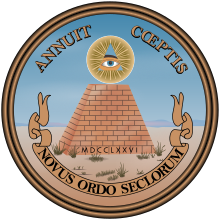Novus ordo seclorum


Novus ordo seclorum (also saeculorum ; Latin for "a new order of the ages") is one of the two mottos on the back of the seal of the United States . The motto to be read above is Annuit coeptis ( Latin for “He is weighed in our ventures”), in between is the eye of providence over an incomplete brick pyramid . At the bottom is the writing Novus ordo seclorum . This - stylized - seal of the USA has been
on the back ( greenback ) of the valid one-dollar note since 1935 ; where the "eye of providence" is represented as a continuation of the pyramid, surrounded by rays.
Origin and meaning
In 1782 Charles Thomson was commissioned to design the seal. He added the words Novus ordo seclorum to express that a new era began with the US declaration of independence in 1776. The intention was also to express that God would bless the new beginning, the “Novus ordo seculorum”.
Originally the phrase Novus ordo seclorum is a quote from the fourth eclogue by the poet Virgil from 40 BC. In this poem, dedicated to the writer and politician Gaius Asinius Pollio , the poet prophesies a new golden age of peace, which should go hand in hand with the birth of a child. The poem is based on the cyclical historical conception of a world year that begins with the reign of Saturnus . This paradisiacal time is now beginning again. Thus Virgil writes in verses 5 to 8 of the Eclogue:
|
|
Interpretations
In the Middle Ages , these verses were often interpreted as prophecy of the birth of Christ . Today, some conspiracy theorists see the program of a New World Order announced in the motto and believe they can recognize signs of the Freemasons , the Order of the Illuminati or other supranational powers in it and the symbols of the seal . A use of the words by the Freemasons cannot be proven. A “New World Order” does not translate into Latin as “Novus ordo seclorum”, but “Novus ordo mundi”.
Individual evidence
- ↑ "He Has Favored Our Undertakings." Michael Stolleis : The Eye of the Law. Materials for a modern metaphor. In: Yearbook of the historical college 2001 , p. 34 ( online , accessed on July 15, 2017)
- ↑ "He Has Favored Our Undertakings." Michael Stolleis : The Eye of the Law. Materials for a modern metaphor. In: Yearbook of the historical college 2001 , p. 34 ( online , accessed on July 15, 2017)
- ↑ Joachim Riecker: "The secret of freedom is courage". Ancient role models in American foreign policy from Theodore Roosevelt to Bill Clinton . Ferdinand Schöningh, Paderborn 2006, p. 82.
- ↑ Thomas White: Dollar Bill. In: Peter Knight (Ed.): Conspiracy Theories in American History. To Encyclopedia . ABC Clio, Santa Barbara, Denver and London 2003, Vol. 1, pp. 226 f.
Web links
- www.greatseal.com (English)
- www.etymonline.com - Etymology Dictionary (English)